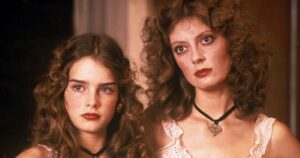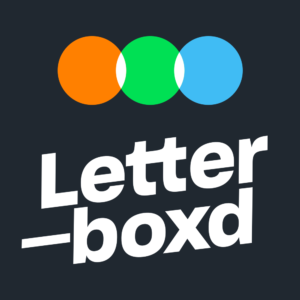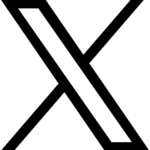Directed by Charles Sellier
Written by Michael Hickey
Starring:
- Robert Brian Wilson as Billy Chapman (at 18)
- Lilyan Chauvin as Mother Superior
- Gilmer McCormick as Sister Margaret
- Toni Nero as Pamela
- Linnea Quigley as Denise
- Charles Dierkop as Killer Santa
- Will Hare as Grandpa
- Tara Buckman as Ellie (Billy’s mother)
- Danny Wagner as Billy Chapman (at 8)
- Jonathan Best as Billy Chapman (at 5)
Rating: ![]()
Exploitation cinema, that eternal rogue of film history, has always thrived in the shadows—delighting in the grotesque, the indecent, and the unapologetically profane. It is a genre defined not by restraint, but by escalation. Each new entry seeks to outdo the last in a perverse tournament of excess: the most gratuitous violence, the most gallons of blood spilled, the most carnal indecencies paraded before a complicit audience. In this nihilistic circus, traditional measures of quality dissolve. A film need not be “good” in any conventional sense. What matters—what has always mattered—is how far it is willing to go. How dirty, how revolting, how brilliantly vomitous it dares to be.
In this sordid arena, the 1970s and 1980s reign supreme. These were decades when taboos were not merely broken, but flayed alive. European filmmakers took the lead in stylization, crafting violent operas of psychological delirium and aesthetic flourish—most notably in the giallo. But the Americans, rougher and more vulgar in their approach, found their own voice in the raw, blood-soaked poetry of the slasher film. Where the gialli were baroque fever dreams, American slashers were lean, mean moral parables masquerading as trash. Post-Halloween (1978), the genre exploded into the public consciousness. What began as fringe became mainstream. Trash cinema was no longer hidden in grindhouse theaters—it was now available in your neighborhood cinema. And, curiously, the public couldn’t get enough.
Perhaps there is a repressed desire in all of us to watch sin punished through fictitious violence. Perhaps in every drop of fake blood lies a little rebellion against the patronizing moral order. These films weren’t just about entertainment—they were about release. In a world saturated by the sanitized and the saccharine, the slasher offered something raw and strangely honest.
Enter Silent Night, Deadly Night (1984), a film that took this philosophy to its most sacrilegious extreme. Released by Tri-Star Pictures in a calculated strike against holiday decorum, the film was an instant commercial success, but it also incited outrage—moral guardians and parent groups decried its existence, calling for bans and boycotts. And yet, it persists. It endures not simply because it is outrageous, but because it speaks—albeit crudely and viciously—to something far more profound.
The premise is both absurd and archetypal: on Christmas Eve, a young boy named Billy Chapman witnesses his parents slaughtered by a man dressed as Santa Claus. This formative trauma, compounded by the punitive dogma of a Catholic orphanage, ferments in silence. Billy is raised not with love, but with fear. Discipline replaces compassion. Morality becomes a weapon. And so, when the adult Billy (Robert Brian Wilson), now employed at a toy store, is coerced into donning the red suit himself, the mask of sanity slips. What emerges is not a man, but a wrathful specter of holiday perversion: Santa as punisher, avenger, executioner.
There is something haunting in this transformation—a dark fairy tale where the innocent becomes the monster, shaped by the very institutions meant to protect him. The narrative reads like an inverted bildungsroman: Billy does not grow into virtue, but into violence. And while the film’s execution is often crude—the editing jagged, the cinematography uninspired, the performances theatrically stilted—it paradoxically enhances the viewing experience. The lack of polish feels almost intentional, as if to reflect the disintegration of Billy’s psyche. This is not a clean descent; it is messy, erratic, painful.
Director Charles E. Sellier Jr., better known for family-friendly television programming, approaches the material with a kind of naive sincerity that becomes strangely effective. Michael Hickey’s script, with its lurid plot and ironic undertones, gives Sellier the foundation to construct moments of shocking poignancy amid the sleaze. The toy store massacre, cloaked in twinkling lights and festivity, stands as one of the film’s most memorable sequences—visually grim, emotionally grotesque, and yet possessed of a surreal beauty.
What separates Silent Night, Deadly Night from its contemporaries is not merely its holiday gimmick, but its malicious sense of purpose. There is venom in its voice. Every kill feels like a bitter exhalation, not of sadism, but of grief transfigured into rage. Unlike many slashers, which focus on the mystery or cunning of the killer, this film centers on trauma—on the psychological detritus of a boy taught to equate virtue with violence. Billy is not an unknowable specter; he is heartbreakingly human, and that makes his rampage all the more unsettling.
The film’s subversion of Christmas iconography is where its genius—and blasphemy—truly shines. Santa Claus, a figure of warmth and innocence, becomes a symbol of punishment. The yuletide setting, with its artificial cheer and moral platitudes, is mercilessly deconstructed. Every carol, every snowflake, every wrapped gift becomes an ironic counterpoint to the carnage. In this way, the film does more than shock—it mocks. It turns the season of goodwill into a bloodbath, and in doing so, it questions the moral foundations upon which these rituals stand.
There is something exhilarating in its cruelty. One cannot help but laugh—not because the film is humorous, but because its audacity is sublime. This is cinema at its most spiteful, and therefore, at its most honest. Its cynicism is refreshing, especially in a genre often dismissed as shallow. Silent Night, Deadly Night reveals the rot beneath the ribbon, the guilt beneath the gift, the anger beneath the angel.
In the end, this film is more than a holiday slasher. It is an accidental masterpiece of transgressive cinema—a furious, unhinged critique of tradition, repression, and the monstrous shapes our traumas can take. It asks not for our approval, only our attention. And if we can stomach its savagery, we may find, buried beneath the blood and broken baubles, a terrible kind of truth.









